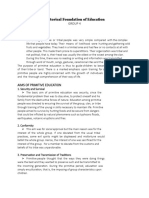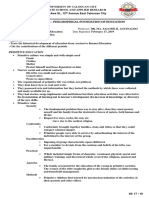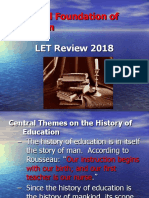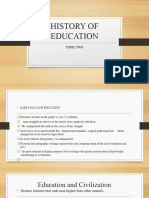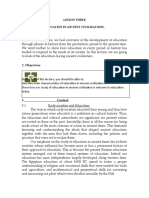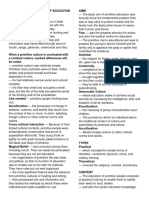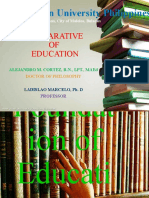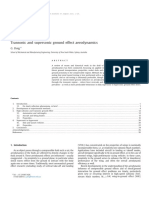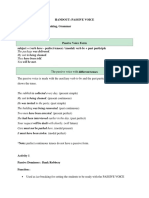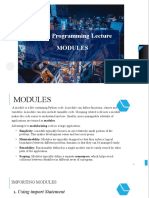West Visayas State University
Lambunao Campus
College of Education
Lambunao, Iloilo
Module in
Ed 202
The Teacher and the Community,
School Culture and Organizational
Leadership
Dr. Maria C. Lastimoza
Dr. Fema Lina L. Baltar
1
� West Visayas State University
Lambunao Campus
College of Education
Lambunao, Iloilo
UNIT 0
Direction: Read and think over.
University
Vision: A research university advancing quality education towards societal
transformation and global recognition.
Mission: WVSU commits to develop life-long learners empowered to generate
knowledge and technology, and transform communities as agent of change.
Core Values: Excellence, Creativity and Innovation, Service
Institutional Outcomes for Instruction:
Taga-West
Institutional Outcomes for Instruction:
-is a creative and critical thinker;
-is an effective and responsible communicator
-has uncompromising personal and professional ethical standards
-is technologically –skilled
-has the ability to conduct research
-has teaming and collaborative skills
-is socially responsible and has strong national identity
-is globally competitive
-is self- directed, competent, and accountable professional
-can utilize lifelong learning skills for personal development
- excellence in professional practice
Campus/College Outcomes:
Taga-West (Lambunao-Campus):
-is value-laden professional (responsible, accountable, independent,
resourceful, trustworthy, refined, God-fearing, service oriented,
considerate of others, tactful);
-is expert/competent of his/her field (skillful/talented, versatile, productive,
competitive, artistic, confident);
-is life-long learner, change agent, innovative, resourceful); and
-has communicative competence (articulate, has language facility, can
open/relay ideas clearly.
College of Education Outcomes:
The college of education must have:
1. exhibited and nurtured a culture of excellence;
2. produced effective facilitators of learning;
3. initiated, undertaken researches and extension services in teacher
education and allied fields;
4. collaborated and shared expertise with local and international
entities/agencies; and
2
� West Visayas State University
Lambunao Campus
College of Education
Lambunao, Iloilo
5. provided with equitable access to educational opportunities to
deserving clientele.
Name:____________________________________School Year:__________Semester:_______
Course:__________________Year:_____________ Section:____________
1. Direction. Essay. What can the College of Education expect from you as one of the
students of WVSU-Lambunao Campus?
3
� West Visayas State University
Lambunao Campus
College of Education
Lambunao, Iloilo
UNIT I
EDUCATION IN THE CONTEXT OF DIFFERENT SOCIETIES UPON WHICH THE
SCHOOLS HAVE BEEN ESTABLISHED
Lesson 1. Primitive, Oriental, Egyptian, Greek, Spartan, Athenian, and Roman
Education
Direction: What are your views about education?
Acquire New Knowledge
PRIMITIVE EDUCATION
Education is as old as life itself. Prehistoric man passed on to his offspring skills
and attitudes for them to survive. To feed, clothe, shelter and protect himself were
primitive man’s activities. Primitive people have narrow social and cultural contacts. They
are extraordinarily conservative and prone to superstition and clung to old ideas and
ways of behavior. They lived in a world as people with unseen beings, ghosts, spirits,
and deities. Illness, famine, storms, accidents, and failure were attributed to actions of
ill-disposed spirits. Primitive life was tribal. There is an absence of reading and writing
AIMS OF PRIMITIVE EDUCATION
The basic aim of primitive education was security. The fundamental problem then
was to stay alive, to protect oneself and his family from destructive forces of nature,
both human and divine. The primitive man’s educational aim was to prepare the young
to secure himself and his family and to appease the gods or spirits that controlled his
4
� West Visayas State University
Lambunao Campus
College of Education
Lambunao, Iloilo
existence. His respect for trees, rocks, the sun, etc. gave rise to the earliest religion,
animism.
The second aim of primitive education was conformity, since this was basic for
social security.
Primitive education aimed at securing the continued existence of the group by
restricting the activities of its members.
TYPES
Primitive education involved two types: Practical, includes simple forms of
domestic, vocational, physical, moral and military training, and theoretical, includes
religious, musical and literary.
CONTENT
The education of primitive people consisted of physical training to enable them to
satisfy their need for food and shelter; spiritual or ceremonial training necessary to deal
with unforeseen forces; and social knowledge to learn the customs, taboos and
traditions for harmonious living with the other members of the tribe.
AGENCIES
The family accounted for the education of the young in primitive societies.
Women taught the girls duties of child rearing and household management. Men taught
boys hunting, fishing, fighting, making tools and weapons and how to propitiate the
gods. When the youth equaled the elder’s knowledge, education was complete. When
one person surpassed the other in strength, physique, age or ability in council, or in
making a better weapon, he became the tribal chief.
METHODS
Primitive children learned by unconscious imitation of the activities of their
parents and other elders. They observed and later became participants. These were the
conscious method. They learned by telling and demonstration, trial and error and from
experienced.
ORGANIZATION
Primitive education was mostly random and incidental with no grades or levels of
instruction with no grades or levels of instruction. Children were required to follow
customs and traditions through imitation of approved ways. Conformity to work and
worship was the means to attain security, the chief aim of primitive education.
ORIENTAL EDUCATION
The earliest civilization developed along the region of Mesopotamia and the Nile.
By settling, however, these tribes became subject to conquest by nomadic tribes. The
result was a mingling of the folkways of the conquerors and those of the conquered;
consequently, there developed a higher level of culture.
The leaders of the dominant tribes became the kings and priests who organized a
complex government which demanded obedience from the people. Well-organized
5
� West Visayas State University
Lambunao Campus
College of Education
Lambunao, Iloilo
political, economic, and religious institutions developed, centered around the need for
maintaining a way of life.
EGYPTIAN EDUCATION
Egypt is one of the earliest civilizations settled by a Hamitic people who inhabited
the Valley of the Nile 20,000 years ago.
The education curriculum in ancient Egyptian education system was well-rounded
and instructed children in almost all forms of knowledge that existed at that time. While
girls could not go to school, they were sometimes given education in certain disciplines
that were considered fit for women. This included dancing, weaving, and baking.
Girls of nobles and royals could read and write as well, even though this freedom
was not available to the girls from lower classes. The purpose of ancient Egyptian
education, other than forming educated individuals, was to maintain the structure of
society as it was envisaged by the ruling class of the time.
AIMS
The aim of education was both cultural and utilitarian: cultural, to preserve and
perpetuate culture; utilitarian, to transfer skills from father to son so that the son could
run his daily life.
TYPES
Domestic training, religious and vocational- professional types dominated
Egyptian Education. Women education was vocational. In higher social circles, the boys
were trained by scribes who taught them how to read and write. To hasten this training,
court schools were set up and the court officials taught a group of boys. The court
school was an apprenticeship in the duties of royalty.
AGENCIES
The home provided basic education for the Egyptian child. Household chores,
religious and moral training and reading and writing were taught by elders and priests.
The temples were the centers of advanced learning. The high priest taught applied
mathematics, astronomy, physics, architecture and embalming. Education in medicine,
priesthood, and the military was largely through parental apprenticeship. Among the
elite, court schools also taught the youth the duties of royalty, also through
apprenticeship.
ORGANIZATION
The home was the first school. Higher learning was dispensed by priests in
temple colleges. Apprenticeship was prevalent in the skill profession. Military and
vocational schools also flourished.
METHODS
Dictation, memorization and copying of texts were the chief methods. Imitation
and repetition of stories, myths and legends perpetuated their culture. Observation and
participation occurred in certain subjects. Internship or apprenticeship was common in
vocational levels while practice was rigid for inculcation of religious and moral precepts.
6
� West Visayas State University
Lambunao Campus
College of Education
Lambunao, Iloilo
GREEK EDUCATION
Childhood education in ancient Greece was highly dependent on one’s gender.
Greek education was the beginning of creativity and logical thinking. It gave the era of
higher culture and creativity. Greeks became the first and greatest sportsmen. In
totalitarian states, they claimed full authority over the lives of individuals. Marriage was a
duty to the state and a matter of religion and patriotism.
Sparta and Athens are the two major city states. Sparta-was a totalitarian soldier
state where obedience and discipline reigned; Athens was a free- functioning political
entity whose citizen enjoyed self-expression.
SPARTAN EDUCATION
To be Spartan was to be strong and hardy, physically fit, terse of speech, austere
and full of valor. They had all the time for the art of war and the training of a soldier-
citizen. Family life was reduced to a minimum because they believed that family interest
led to money-making. By taking the men out of the house and inventing public mess
halls, every man was father and school master to every Spartan boy.
Education was the supreme concern of the Spartan state; their constitution read
more like a description of a military academy than that of the government. Public
authorities decided whether marriage should be sanctioned or forbidden; and the
children belonged to the state, not to the parents.
AIMS
The Spartan Constitution aimed at training a powerful body of soldiers making
the state a perpetual military camp. Spartan education aimed to develop a nation of
unequal military skill with citizens absolutely devoted to the state.
Spartan education aimed to develop the capacities of men only for war. Courage,
respect for elders, subjection to the state, loyalty and obedience to authority were rigidly
inculcated. The finer sentiments of civilized life were rejected.
TYPES
Physical education and military training predominated Spartan Education. Spartan
moral training was a product of group living and traditional ceremonies. Instruction in
music and dance was physical training to build an attitude for war. Domestic training
was suppressed since household duties were done by slaves.
CONTENT
The Spartan curricula consisted of military exercises and practices essential to a
life of devotion and service to the state. The state provided for the complete control of
the training of children which began at birth. The newborn infant, if healthy, was
returned to the mother, who was in realty a state nurse. Her boy was cared for until he
reaches seven; she reared him in the most austere discipline. Boys were trained to keep
absolute control of their feelings, appetites, habits and they were taught to be obedient
7
� West Visayas State University
Lambunao Campus
College of Education
Lambunao, Iloilo
and respectful, modest and reserved. Girls were trained to be healthy and courageous so
that they could bear healthy children, their greatest contribution to the state. Reading
and writing were taught to a very limited extent.
AGENCIES AND ORGANIZATIONS
The state was the dominant educational agency. The state controlled the
education of the individual from birth to death. Family life was controlled by the state. All
children belong to the state.
Spartan boys lived in barrack type school under the training official called
paidonomous. They had rigorous training in games and drill under a youth supervisor.
At twenty, after taking an oath of allegiance, the boys were dispersed to military camps
for actual combat. At thirty they become full-fledged citizens and were required to marry.
The home served as the school for the girls.
METHODS
Education in Sparta was achieved by training rather than by school instruction.
Learning was facilitated by activities and ceremonies led by elders and military leaders.
Discipline was cruel and very harsh. Even inattention, lack of awareness and moral
delinquency were punished.
ATHENIAN EDUCATION
Athens was another Greek city state. Solon (639-559 BC), who belonged to one
of the noble families, brought order to Athens and the attitudes toward education sprang
from his influence. He instituted reforms in government and made it a true democracy
unlike Sparta which was founded on slave economy.
The social scale was simple. At the top stood the citizen who owned the land,
below them were aliens who engaged in commerce and manufacturing and at the
bottom were the slaves. The citizens ran the affairs of government. The government was
a direct democracy- every citizen took part on an equal footing in the conduct of
government. Every citizen served on the jury, acted as judge and fought as a soldier.
AIMS
Athenian Education aimed to develop individual excellence which meant a full-
rounded development of mind and body and public usefulness, the ability to take active
part in the business of state. Athenians sought beauty and grace of body, knowledge
and things of the spirit. The idea of manhood embraced external and internal beauty,
physical and mental harmony.
TYPES
Civic Training was the dominant type; physical training developed grace and
harmony, moral training emphasized old virtues, intellectual training was the type
needed for the activities of the assembly and the market place. Music, poetry, and
dancing were taught to develop personality and ennoble the intellect.
8
� West Visayas State University
Lambunao Campus
College of Education
Lambunao, Iloilo
CONTENT
The Athenian boys were taught reading, writing, and arithmetic. Selected verses
were dictated, memorized and chanted. They studied music, art, poetry, games and
sports. As a boy matured, he acquired military skills and practiced civic virtues necessary
for his role as a citizen in a democratic state.
AGENCIES
Education in Athens was supervised by the state. The house did very little
because the women were not educated except for few “heterae”, cultured women, who
participated in social life and intellectual discussions of the upper class males. The
schoolboy was assigned to the care of a paidagogous, once a slave, but very learned.
Paidagagous was charged with teaching the boy the intricacies of manners and morals
and assuring the safe delivery of his ward. The first schools were private and secondary
and higher education did not yet exist so that by the age of 14, education was over for
most boys.
When conventional schooling ceased, his education began; he participated in
activities of city life; he went to assemblies and heard skillful debates; he learned the
laws, exercised and interpreted them; at the theater; he listened to the classics and
histories of people; and in the Olympic Games, he came in contact with Greek culture.
The state provided for public gymnasium called palaestra. Here the youth trained until
he reached 18 years of age and was thus ready for military life. He became ephebos, an
apprentice militiaman. A variety of schools existed, each taking acre of a certain aspect
of development. There were three types of teachers: the Kitharist or teacher of music,
the grammalist or teacher of letters; and the paedotribe or teacher of gymnastics.
ORGANIZATION
Until the age of seven, an Athenian boy lived at home, usually under the care of
slaves. From seven to sixteen the boy divided his time between the didiscaleum (music
school) and the palaestra (gymnasium) usually accompanied by his slave tutor. After
sixteen, he continued his physical education at the palaestra. He was trained by a
drillmaster called paedotribe and was under the supervision of a state moral sensor, the
sophonist. As an ephebos (18-20) he spent his days in military service and was given the
privileges of full citizenship.
METHODS
Much of the learning was by imitation, usually of a living model. Readings were
memorized. Most of the education came from participation. Discipline was severe and
corporal punishment was used extensively.
After the fifth century B.C., greater emphasis was placed upon the teaching of
the sophists or wandering scholars who came to give instruction to the Greeks for fees.
They give intensive training in speech emphasizing grammar, rhetoric, and oratory. They
also emphasized the development of reasoning and critical thinking, the rhetoric schools
and the philosophical schools. The rhetoric schools continued the sophist idea of
preparing young men for public careers while the philosophical followed the traditions
initiated by Socrates and later by Plato and Aristotle.
9
� West Visayas State University
Lambunao Campus
College of Education
Lambunao, Iloilo
ROMAN EDUCATION
Education was very important to the Ancient Romans. The rich people in ancient
Rome put a great deal of faith in education. While the poor in ancient Rome did not
receive a formal education, many still learned to read and write. Children from rich
families, however, were well schooled and were taught by a private tutor at home or
went to what we would recognize as schools.
First among the traits in the Roman moral ideal was manliness and its most
prominent components were courage and strength. A second Roman trait were
reverential regard for one’s ancestors, for the divine powers and for sacred customs.
AIMS
The aim of early Roman education was the development of the vir bonus- the
good citizen, the good soldier, the good worker. The vir bonus was the man possessed
of all the virtues essential for the exercise of his rights and the discharge of his duties
and obligations.
In latter period of the Roman empire, Roman education aimed for linguistic
facility and perfection in public speaking and debate. The orator, who was considered
the ideally educated man, was to be the first vir bonus. The true orator used his learning
by putting it to practical use in public service.
TYPES
Early Roman Education was essentially practical training for the affairs of life.
Moral duties and rights were clearly defined by law, both moral and civil and were tied
up with religious training. Vocational education had a respected place in early Roman
education. In the latter, years a few leaders were getting broad intellectual training,
while the great mass of the population were getting the narrowest vocational training,
with less and less oral training. These brought about moral decay. The Romans were
only interested in material things that satisfied their senses and their appetites.
CONTENT
The content of early Roman education was practical and moral in character. The
boys learned the laws of the twelve tables, roman history, the procedures of court and
the senate, conduct of war, business, agriculture, sports, and the use of weapons; the
girls prepared for domestic life and religious functions.
At home, the child played vigorously. As a boy grew older, he went about in the
company of his father. If plebeian, he joined his father to banquets and forums listening
to discussions and debates.
In later Roman times, elementary education included the rudiments of the 3 R’s.
In the Sunday school, grammar, which included literature and language was the chief
subject. The practical character of Roman life was stressed while history and geography
were taught only for functional importance. In the higher school, rhetoric was
emphasized. It consisted of debates, extemporaneous speaking and declamation.
10
� West Visayas State University
Lambunao Campus
College of Education
Lambunao, Iloilo
AGENCIES and ORGANIZATION
Education in Roman life was dominated by the family. The family shaped the
character and determined the status of its members. The father was the head and his
authority was absolute although wives were held in high esteem. Religious activities
were headed by the priest and each member of the household performed particular
religious functions assigned by custom.
There were three level. The first level was the elementary school where reading
and writing were taught. The teacher was the ludi magister. The next level was the
grammar school, a school teaching the liberal arts, the teacher of which was called
grammaticus. The third level was the school of rhetoric in which boys were prepared for
careers as orators. Teachers were called rhetors.
The Roman had an organized educational ladder: on the elementary level,the
school of the literator on the secondary level, the school of the gramaticus and the
school of the rhetor for higher education.
METHODS
At the elementary level, memorization and imitation were used. Punishment was
severe. At the secondary level, the method was largely one of the exercise in good
literary discourse and moral habits. Declamation was emphasized in the rhetorical school.
All types of public speaking were perfected; eulogies, exhortations, funeral orations and
lectures.
The most influential teachers and thinkers in Roman education were Cicero and
Quintilian.
Cicero said that the ability to speak and to persuade people was of greatest
importance in professional and public life.
Name:______________________________________School Year:__________Semester:_______
Course:__________________Year:_____________ Section:____________
A. Study this picture. Explain the importance of education during primitive time and
compare this with how you view education today.
11
� West Visayas State University
Lambunao Campus
College of Education
Lambunao, Iloilo
Source: https://www.google.com
References
San Mateo, R. & Tangco, M. (2003)
Foundations of Education II. Third Edition. Katha Publishing Co. Inc.
https://www.google.com.
Legends and Chronicles (2007-2020). Ancient Egyptian Education.
http://www.legendsandchronicles.com
Lopez, R. (2019). Did sons and daughters get the same education in ancient Greece? History
Magazine. https://www.nationalgeographic.com/
12





